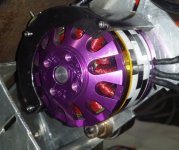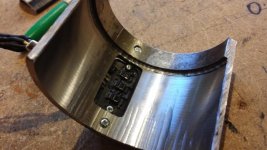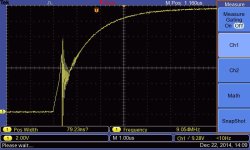I increased phase current to 125amps and all good, just seeing battery current of 55 amps, so may start backing off the battery current setting.
Well , interesting last 4days . Thursday - Controller started cutting out on the way home from work and found my little sun shield to block IR from
the optical sensors was crap. So did a quick fix with duct tape and away it went until some wires got ripped up by the chain.
At this stage I thought my controller had died so pedaled back to work very sad, I fixed the wiring and away it went again.
So Friday night I made a better sun shield and gave the bike a quick test on Sat.


Sunday - decided to do a range test and rode around town , and by the end of the ride the controller was shutting down all the time.
So I had all these ideas about want mite be causing this, I was wondering if the RC filter on the Phase current sensors was to long (1k and 10nF 1TC=10uS),
Desat trigger leveled changed because it was hot that day, Maybe I overheated the motor and shorted out the windings.
Turn out that the stator had moved and stuffed up the timing.
Its been funny, as every time something like this happens I have been blaming the controller. But now the controller
has been the most reliable part on the bike.
I have decided to get a bigger motor as the little motor I am using is getting a bit hot.
I will still use the 2kw controller for now but I am planing on making a 4 to 5kw ESC now.
Does anyone know if I am asking too much for a 12fet controller to do 200 to 250Amps Phase current using IRFP4468PBF mosfets (matched pairs).
Looking at using the RotorMax50cc motor from HobbyKing.
Some pics of how I mounted my mofets and screw them to the heatsink. (I have not seen this method before)
The small round metal things has a M3 thread inside it and I used a rubbery glue to hold it in place.
I then screwed the mosfet to the heatsink from the outside of the case. I did this so I didn't have to
have any access holes in the PCB which was a waste of space.
 View attachment 1
View attachment 1

I used your DC-Link guide HighHopes and have some polypropylene caps on the way. Straight after I was riding the bike I pulled
the cover off the controller and put my finger on the caps, lets just say I dont think they will last very long.






